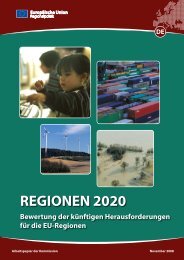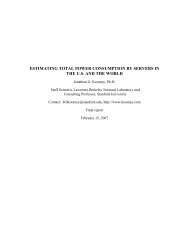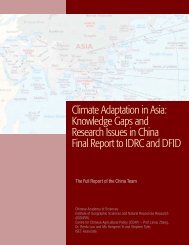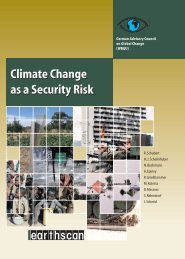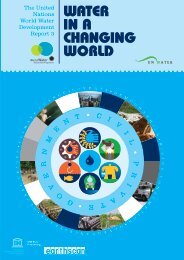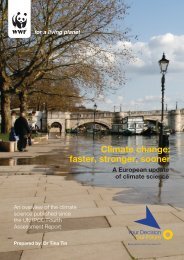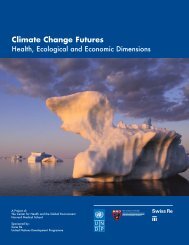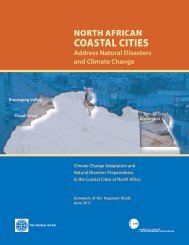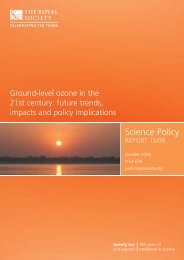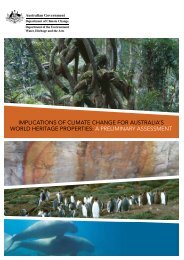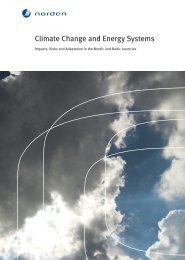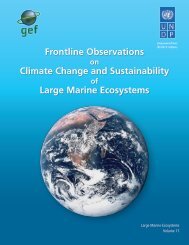Climate Change in Latin America - European Commission
Climate Change in Latin America - European Commission
Climate Change in Latin America - European Commission
You also want an ePaper? Increase the reach of your titles
YUMPU automatically turns print PDFs into web optimized ePapers that Google loves.
1.3. Regional Ecological Footpr<strong>in</strong>t<br />
The ecological footpr<strong>in</strong>t consists of both the impact<br />
of human activities on an ecosystem as well as the<br />
corrective measures taken to mitigate such impact.<br />
Consequently this is a key <strong>in</strong>dicator of susta<strong>in</strong>ability.<br />
In this report the Greenhouse Gas emmissions<br />
(GHGs) from the 18 countries have been used as<br />
way of evaluat<strong>in</strong>g the impact of human activities on<br />
the environment. In Lat<strong>in</strong> <strong>America</strong>n countries, GHG<br />
emissions have the follow<strong>in</strong>g characteristics:<br />
• a medium level of contribution to worldwide GHG<br />
emissions, especially if the total GHGs (12% of<br />
world emissions) are compared to the world's<br />
population and the share of GDP (both equal to<br />
8.5%);<br />
• per capita CO 2<br />
rates show values greater than the<br />
averages of Annex 1 countries;<br />
• greater CO 2<br />
emissions due to changes <strong>in</strong> soil use<br />
and forestry (USCUSS), which are higher than the<br />
amount of CO 2<br />
absorbed, <strong>in</strong> spite of the fact that<br />
the Lat<strong>in</strong> <strong>America</strong>n tropical ra<strong>in</strong>forests are the<br />
planet's ma<strong>in</strong> "green lung";<br />
• average CO 2<br />
emissions from USCUSS are almost<br />
three times the world average and greatly exceed<br />
emissions from other sectors;<br />
• the average CO 2<br />
y CH 4<br />
emissions produced<br />
by the agricultural sector (exclud<strong>in</strong>g USCUSS)<br />
represent 70% of the rema<strong>in</strong><strong>in</strong>g emissions, and<br />
the contribution of CH 4<br />
is higher than averages <strong>in</strong><br />
the world and <strong>in</strong> Annex 1 countries.<br />
Evidence for these po<strong>in</strong>ts can be found when the data<br />
is analysed us<strong>in</strong>g a CAIT (<strong>Climate</strong> Analysis Indicators<br />
Tool). The data <strong>in</strong>clude the amount of CO 2<br />
produced<br />
by fossil fuels and the cement <strong>in</strong>dustry (1850-2005);<br />
CO 2<br />
due to change <strong>in</strong> soil usage (1950-2000), CH 4<br />
,<br />
N 2<br />
O, HFCs, PFCs, and SF6 (1990, 1995, 2000, and<br />
2005); and Houghton, R.A. 2008, for the regional<br />
trends <strong>in</strong> changes of soil usage up to 2005 5 . The GGE<br />
data presented <strong>in</strong> the National Communications from<br />
the 18 countries could not be used, as there is now<br />
way of perform<strong>in</strong>g temporal analyses. Many countries<br />
only presented a GHG <strong>in</strong>ventory. Only four countries<br />
presented this for the year 2000 and only one for after<br />
2000.<br />
Table 2 summarises the perception of the causes of<br />
GHG production <strong>in</strong> the different countries, accord<strong>in</strong>g<br />
to the <strong>in</strong>formation given <strong>in</strong> the questionnaires.<br />
5 Data related to Greenhouse Gas (GHG) Emissions was drawn up<br />
based on the data provided by the <strong>Climate</strong> Analysis Indicators<br />
Tool website, version 6, by the World Resources Institute,<br />
updated to 2005 (www.cait.wri.org). In order to <strong>in</strong>vestigate<br />
regional trends <strong>in</strong> changes to soil usage up until 2005, data<br />
was used from Houghton, R.A. 2008. Carbon Flux to the<br />
Atmosphere from Land-Use <strong>Change</strong>s: 1850-2005. In: TRENDS:<br />
A Compendium of Data on Global <strong>Change</strong>. Carbon Dioxide<br />
Information Analysis Center, Oak Ridge National Laboratory,<br />
U.S. Department of Energy, Oak Ridge, Tenn., U.S.A.<br />
18



